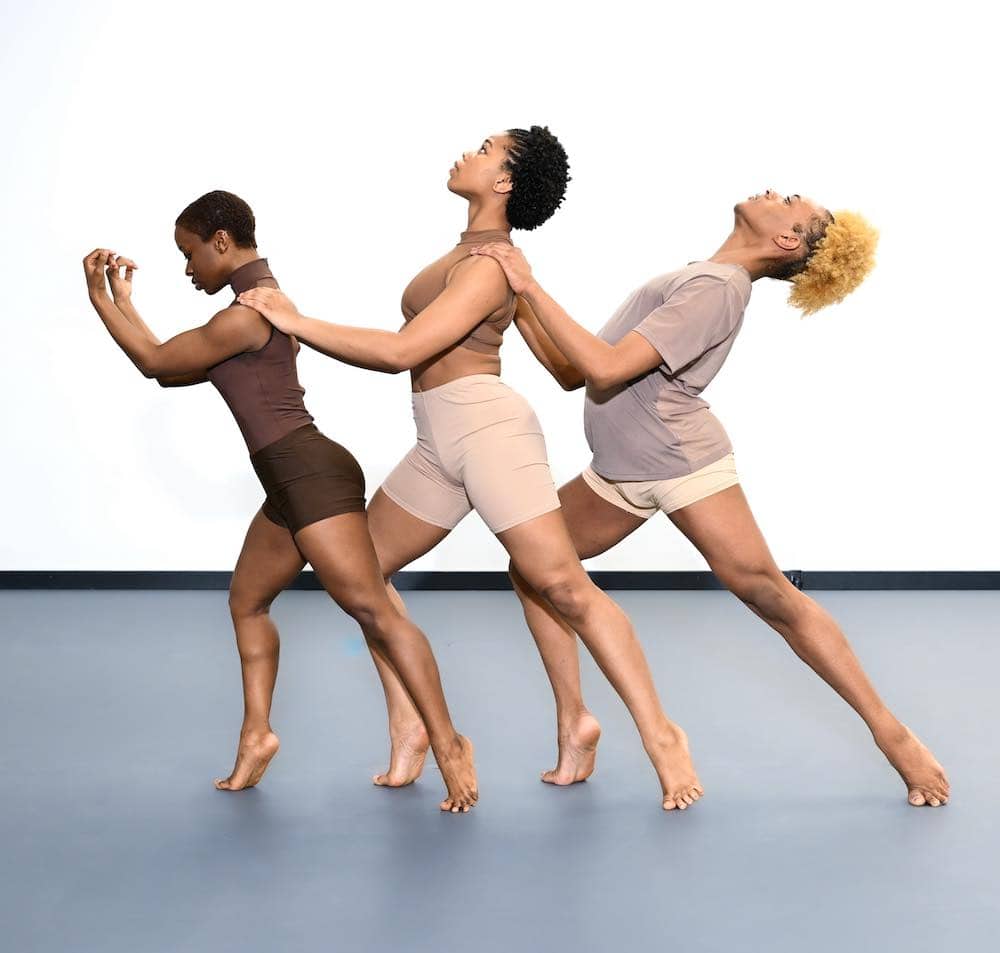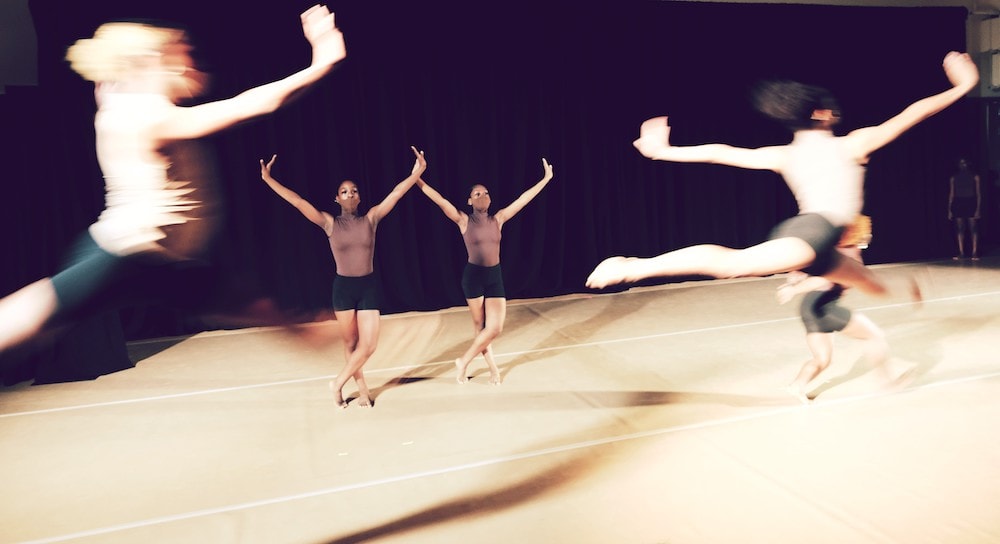Beyond the requisite barres and mirrors, dance studios — particularly ballet studios — carry centuries of hierarchical, colonial, and white supremacist practices. While many never considered the pale pink tights and pink satin pointe shoes, and a preference for thin bodies and long straight hair easily pulled into a bun, racially biased practices, these de rigueur requirements have kept ballet an exclusive — and primarily white — Eurocentric artform.
At VIVA Dance School, these traditions have evolved. Female students wear tights and shoes that match their natural skin tone, whether café au lait or dark chocolate. And hairstyles range from classic ballet buns to braids or even cropped hair. As long as hair is secured and kept away from the face and neck, teachers are satisfied.

The District’s VIVA Dance School has, since 2017, been developing a program to break down these longstanding barriers by covering tuition costs, addressing accessibility and equitable training opportunities, and providing teachers representing diverse backgrounds and experiences. Located temporarily at Joy of Motion Dance Studios on H Street NE, the studio provides high-level pre-professional ballet and dance training along with wraparound services, including tutoring, coaching, and choreography for auditions, and college-application assistance at no cost to its 50 students.
According to executive director and co-founder Kelli Quinn, the school has an annual budget of $1.4 million and receives no tuition income. “It’s 100 percent contributed income,” she noted, meaning the students selected for the program do not worry about paying tuition. “We fundraise via government grants, foundations, individuals, and corporations for investment and support. Our community of support is extremely significant and appreciated and a huge value asset to this school.”
VIVA was conceived from a specific need, according to Quinn, who worked with the DREAM program at CityDance prior to re-shaping the program into VIVA. CityDance, an established dance studio and conservatory training center in North Bethesda, is a predominantly white institution. “With the work that we [at CityDance/DREAM] were doing in the community, we were just seeing so much talent and wanted to create a space for students to be able to train and dance, particularly students of color,” Quinn said. “We looked at building a school around the unique needs of students of color.” Questions they wrestled with included: “What does it look like to build a school that’s accessible to all wards of the city and a school that had full intentionality around its student body’s needs in the studio and beyond?” The school settled in at the former Garnett-Patterson Middle School in Northwest DC, but presently classes are taking place at Joy of Motion’s H Street NE studios, while its future location at the Grimke School at 19th Street and Vermont Avenue NW is undergoing renovation.

“We are very clear in terms of our model and our mission,” stated co-founder and artistic director Chandini Darby. “It is serving and prioritizing students of color.” That is evident in the studio’s curriculum, the intentionality in hiring faculty of color, and the many ways the staff supports the student body. Presently, 98 percent of VIVA’s students are of color.
VIVA is not the first nor only such program in the region, noted long-time dance educator, administrator, and advocate Carol Foster. Jones-Haywood School of Dance on Georgia Avenue in Northwest Washington was founded in 1941 by two African American women and offered ballet classes to Black children in the then-segregated city (three years before the School of the Washington Ballet was founded by two white women, Mary Day and Lisa Gardiner). In 1980, Foster herself created DC Youth Ensemble, which closed in 2017, to train city children in dance, theater, and music. Duke Ellington School for the Arts was founded in Washington, DC, in 1974, just a few years after Dance Theatre of Harlem was founded in New York. In the past few decades, a former Dance Theater of Harlem dancer created Dance Institute of Washington in Columbia Heights, the Washington Ballet opened a campus in Anacostia, and Shawn Short founded College Park’s Ngoma Dance Center, just to recognize a few studios with a specific mission to teach and support young dancers of color.
Foster, who has worked in the dance field for more than 50 years, including teaching VIVA co-founder Darby, noted that lack of equitable funding has plagued the dance field for generations, and dance organizations of color often received the least funding from government, private, and individual contributions. She also pointed to the many established Black-focused institutions that have provided wraparound services similar to VIVA’s, just informally. For example, rather than a dedicated staff member to oversee homework and homeschoolers, such as VIVA offers, Foster said she instructed her dance students to bring in their homework and checked it during rehearsal or class breaks. Many students at Dance Institute of Washington receive scholarships, while students at the Washington Ballet’s THEARC campus receive free or low-cost uniforms and shoes.
“If you’re going to do this work,” Foster said, the additional oversight and support of students’ lives outside the studio “is essential.”

“We also have 100 percent staff and faculty of color here at the VIVA School,” Darby said. “That is centering the idea that representation matters. It’s important that our students see people who look like them, who are working in the field they’re interested in pursuing to really help support them in a pathway to that profession.”
Admission to VIVA is by audition only; auditions for the 2023/24 school year will be held in person in April. The dance curriculum is comprehensive, and as students advance, they attend classes, workshops, and rehearsals up to six days and 20 hours a week. The curriculum includes ballet, modern dance, jazz, contemporary, hip hop, and African dance, plus a summer intensive. “There’s also academic programming, leadership development, and college mentorship,” Darby said. “We’re really supporting students in the studio and beyond … That’s all intended to target where there are gaps in the way students of color are included in conversations around leadership in the arts, art spaces, and how they are showing up in higher education.” This includes everything from understanding the Eurocentric roots of ballet and how to address those in a contemporary setting by, for example, encouraging dancers of color to wear appropriately skin-toned tights and shoes.
Unlike many dance schools, where classes are assigned by age and students are expected to progress as a cohort, VIVA customizes each student’s program as they progress. “Because we are still new,” said Quinn, “last year was our full class that [completed] the breadth of the curriculum, which is comprehensive from the time you come in right through the time you graduate.”
She continued, “Every child, from the eight-year-olds to the 18-year-olds, has their experience tailored to their age group, their level, and their needs,” Darby added. “We also bring in a lot of workshops with guest artists. There’s weekly Pilates classes, and we have full-time dance physio-therapists on site to work with our students, sometimes in workshops, but some students do work with that physical therapist weekly.” Part of educating dancers includes teaching them functional anatomy principles, performance-enhancement techniques, and principles of conditioning to support overall health and wellness, she noted.
With just 50 students, Quinn said, “No student gets lost in our classes. No one is not known or seen. We have a finger on the pulse of every child’s development in this school: There’s no back-line got-lost-in-the-shuffle kids.” She also reported an 85 to 90 percent retention rate, which is notable for such a time-intensive and physically rigorous program.

“We know there are many dance studios [in the area] with hundreds of kids,” Quinn said. “[VIVA’s] student body is considered by many to be quite small, but we think, in the way that we program, it’s quite large … [and] it’s one of the reasons why we extract the financial barrier so it does not become a driver for who is in the school and who is not.” While Darby and Quinn look to expand the program in coming years, it will grow to no more than 75 students in total.
“I applaud Chandini and VIVA [for] wanting to do this on their own in their own way,” said Foster, 74, who founded, directed, and advised numerous dance programs over her 55-year career. “I think they might have the right formula … and anytime someone is trying to push kids forward, that’s the right thing to do,” Foster added. “If you’re going to do this with these kids, you can’t just put them in leotards. We [African Americans] are a holistic people. We live holistically. We learn holistically. We create holistically.”
The studio is named VIVA School because it’s a word in several languages, according to Quinn. “It means life … or live, and it resonates for English and Spanish speakers. In many countries, it’s used as a rallying cry. You’ll hear ‘viva’ in stadiums with people cheering. That’s the essence of what we do here at the school: We are advocating, cheering our students on every day, every step of their journey. This community is here for our students. VIVA is a rallying cry for the talent here. This place holds so much life … and so much possibility.”
Upcoming VIVA School of Dance programs include Spring Auditions for ages 6–14, April 22, 2023; Claye Series Performance (student choreography presentation) at The Kennedy Center REACH Campus Sunday, May 7; and VIVA’s 2023 Annual Concert at the Lincoln Theatre, 1215 U Street NW, Saturday, May 20.
For more information about the VIVA School of Dance and to donate, visit thevivaschool.org.
About the Wendi Winters Memorial Series: DC Theater Arts has partnered with the Wendi Winters Memorial Foundation to honor the life and work of Wendi Winters, the DC Theater Arts writer who died in the Capital Gazette shooting in Annapolis, Maryland, on June 28, 2018. To honor Wendi’s legacy, the Wendi Winters Memorial Foundation has funded the Wendi Winters Memorial Series, monthly articles to be produced by DC Theater Arts to bring attention to theater companies and theater practitioners in our region who engage in exemplary work that makes our community a better place. The centerpiece of these articles is a series we are calling “The Companies We Keep,” articles offering an in-depth look at one local theater company each month. In these times of division and conflict, DC Theater Arts chooses to celebrate those who do good.
For more information on DC Theater Arts’ Wendi Winters Memorial Series, check out this article graciously published by our friends at District Fray Magazine.





